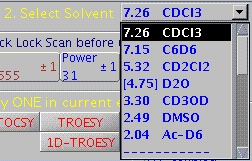Contents
|
|
changes in instrumentation in the NMR labs, EB-44 lab renovation |
|
|
|
|
|
Department of Chemistry,
University of Alberta February
2009
NMR News 2009-01
News and tips from the NMR support group for users of the Varian NMR systems in the
Department
Editor: Albin.Otter@ualberta.ca
http://nmr.chem.ualberta.ca
There are no fixed publishing dates for this newsletter; its appearance solely depends on whether there is a need to present information to the users of the spectrometers or not.
|
Contents
|
Changes in instrumentation
in the NMR labs
Most of the NMR News readers probably heard a lot of rumors for quite some time
that a new NMR instrument will come our way. This is correct. A new Varian
700 MHz spectrometer (v700) has been funded by a grant from Canadian Western
Diversification to the Carbohydrate Center in our Department. The spectrometer
was ordered in December and will be installed later this spring in EB-44 (the
same lab the two 500s are in). This instrument will make use of so-called
cryo-probe (also called cold-probe) technology. In these probes the H1 and C13
receiver coils as well as the respective pre-amplifiers are cooled to about 20 K
(almost liquid helium temperature). This reduces thermal noise and the probe
reaches sensitivity levels that are way better than ever possible with a
conventional room temperature probe (all our current probes are of that kind). A
cryoprobe is about 10 times more expensive than a regular probe (ca. $300K) and
therefore it should not be a surprise when access to the v700 will not be
unrestricted. Details will be published once instrument access rules have been
established.
The good news do not end here. The u500 will be upgraded with its own cryoprobe (expected in the second half of 2009). This one, called Xsens, is optimized for maximum C13-sensitivity. It is expected to be 10 times more sensitive than our best C13 probe in current use. A 10-fold increase in probe sensitivity implies a 100 times shorter time to reach a certain signal-to-noise level at a given sample concentration. That opens, beyond a doubt, new opportunities for natural abundance C13 NMR. It will also be good for H1 as the H1 coil is cryo-cooled too, and thus providing about 4-5 times better H1 sensitivity than the current probe.
This is where the good news end, unfortunately. The EB-44 lab needs substantial renovation work to accommodate the v700 spectrometer and the cryoprobe equipment. Among many other things, chilled water has to be brought into that lab to supply the entire cryoprobe "machinery" (there is quite a bit of it). We will have no choice but to crate up the u500 for quite some time during the renovations. The magnet will stay on field but it will be inaccessible and hence u500 will be unusable. Exact times are unknown but we estimate that this will not happen until about mid-March, but then suddenly without much further warning. It is impossible to guess the duration of the interruption but it could be a month or more. Worse, it cannot be ruled out that even the ibd5 in the same room has to be put out of service but likely for a much shorter time. ibd5 has a shielded magnet and that makes it less problematic during renovations. The on-line reservation system will, of course, show when one or both 500s become unavailable.
Change of computer hardware
and software
The new v700 will be the second spectrometer (after u500) that only runs with a
certain version of VNMRJ and not with the old VNMR. Varian no longer
supports VNMR on the Sun computers that we use on 6 of our 7 instruments. Since
June 2007, there were periodic reminders in this Newsletter that one day VNMR
will no longer be available. Explicit or implicit NMR users were encouraged to
switch to VNMRJ. Starting in the very near future, we are replacing the
Sun/UNIX/VNMR systems with Linux/VNMRJ systems. We expect this process to
continue for a couple of weeks if not a month or two. The first to go
"VNMRJ-only" is i300 in the sub-basement, followed by i600.
Nearly all users who switched to VNMRJ find its usage much more easy than the
old software. The main difference, based on user feedback, seems to be the issue
of solvent selection. VNMR's buttons to set up an experiment forced a
user to click on a solvent button, so the solvent selection was not automatic
but part of a routing that made it appear automatic. In VNMRJ/EZ NMR a user can
switch back and forth between various experiments and select NMR techniques
without being "forced" to select the solvent. Solvent information is not
automatically transferred from one exp to another (neither was it in VNMR).
Correct solvent selection is critically important to
the successful operation of the spectrometer because parameter sets,
referencing etc. are based on the solvent. It is far from difficult to select
the appropriate solvent (as shown below). The only challenge is not to forget
it!
 |
Solvent drop-down list (item number 2 in EZ NMR) |
solvents: spectra with common impurities
This is not exactly new but often overlooked: H1 and C13 spectra of the most
common solvents including typical impurities such as water are on the NMR web
site and can be accessed here.